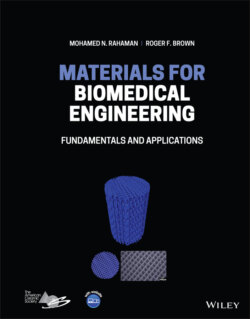Читать книгу Materials for Biomedical Engineering - Mohamed N. Rahaman - Страница 32
1.5 Case Study in Materials Design and Selection: The Hip Implant
ОглавлениеModern implants for total hip replacement (Figure 1.1b) provide a useful example of the design and selection of biomaterials. While these implants do not reflect the aforementioned trend in which biological sciences are playing a more significant role in biomaterials design, they take into account some advances, such as the response of cells and tissues to implanted biomaterials. Although the hip implant has not changed considerably in its overall geometry since Sir John Charnley first implanted it into patients around 1960, the incorporation of advances in materials science, engineering, and biological principles into materials selection has resulted in the creation of longer‐lasting implants having better performance. Currently, approximately half a million total hip joint replacement surgeries are performed annually in the United States and elsewhere in the world, which provide an improved quality of life for this significant number of people.
The human hip joint consists essentially of a femoral head with an approximately spherical surface, which articulates within a socket in the acetabular bone (Figure 1.6a). A prosthetic hip implant attempts to reproduce these geometrical features (Figure 1.6b). It consists of three major parts, a femoral stem, a femoral head (also called a ball), and an acetabular cup (socket) composed of a liner and a shell (Figure 1.7). The stem is inserted into the femur to provide stability for the femoral head, which articulates in the liner of the acetabular cup that is secured to the pelvic bone. Important factors in materials design and selection for these three components of the hip implant are discussed in the following sections.
Figure 1.6 Illustration of (a) the human hip joint and (b) an artificial hip joint used to repair a damaged or diseased hip joint.
Source: From Rahaman et al. (2007) / with permission of John Wiley & Sons.
Figure 1.7 Image showing the components of an artificial implant used for total hip joint replacement.
